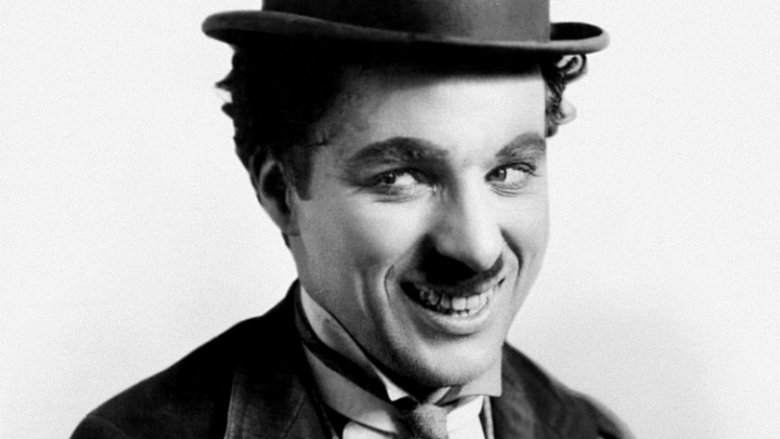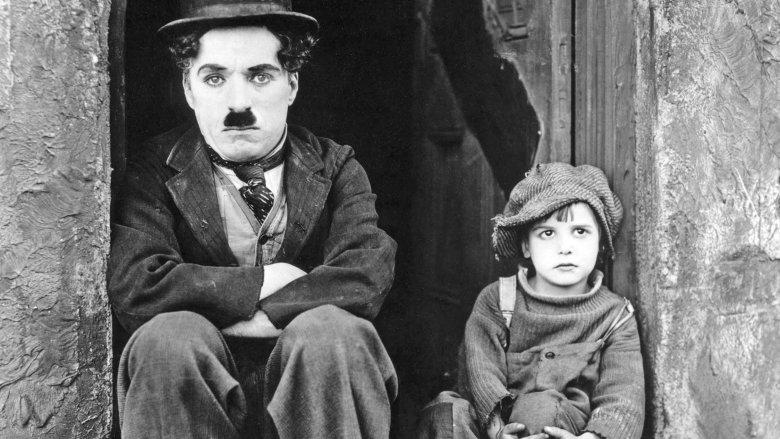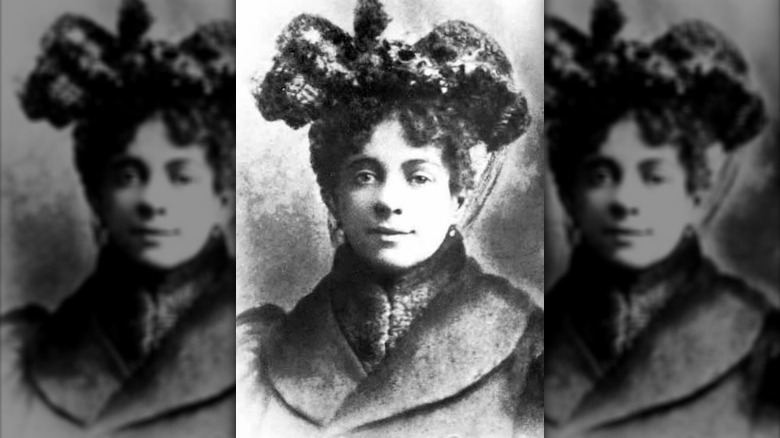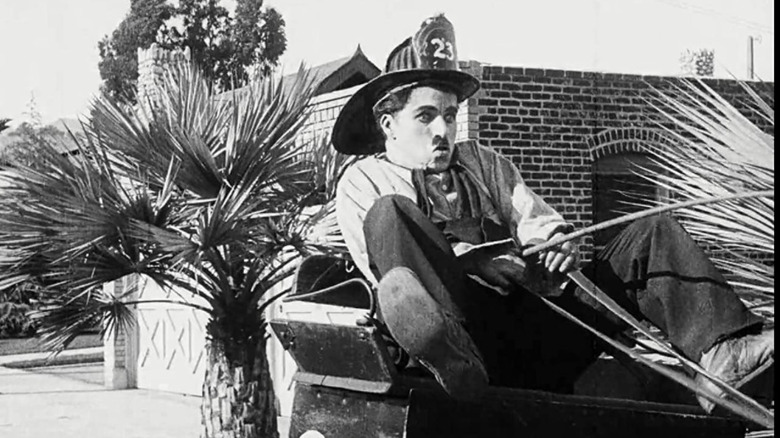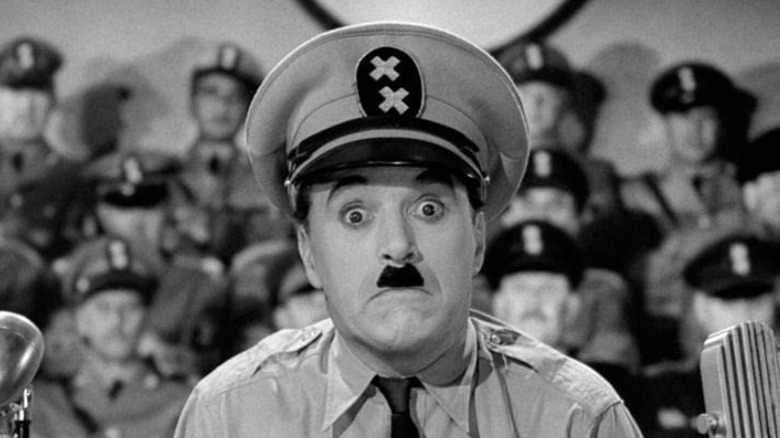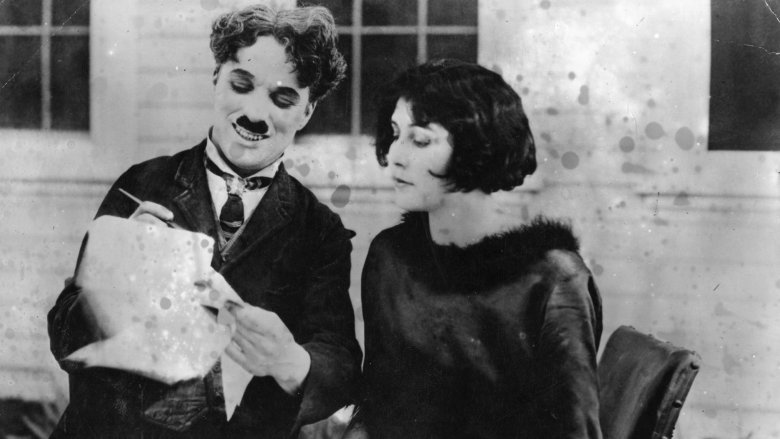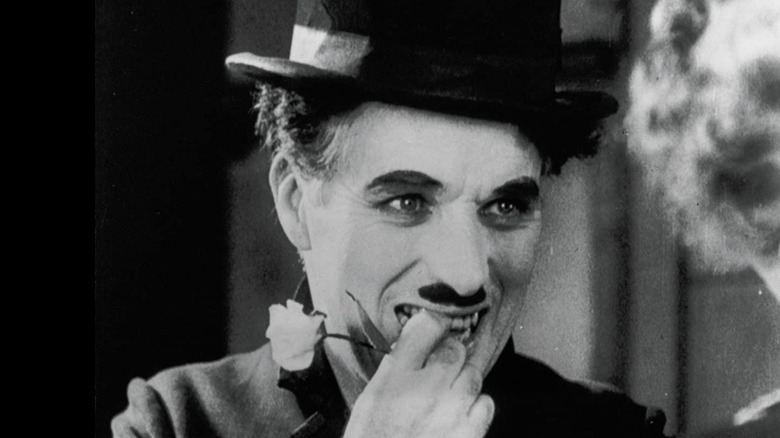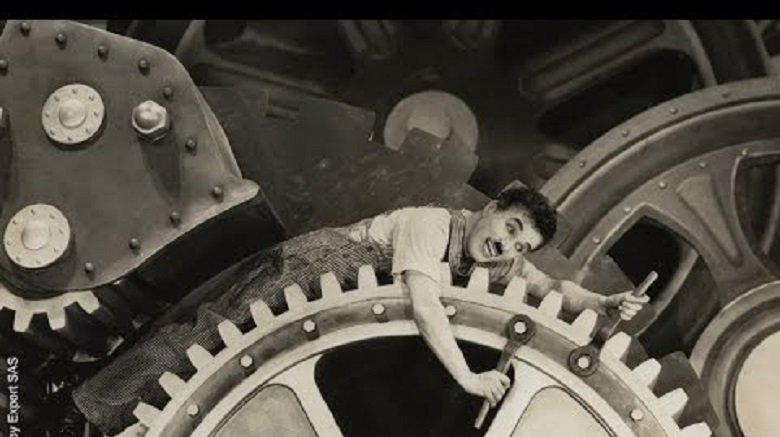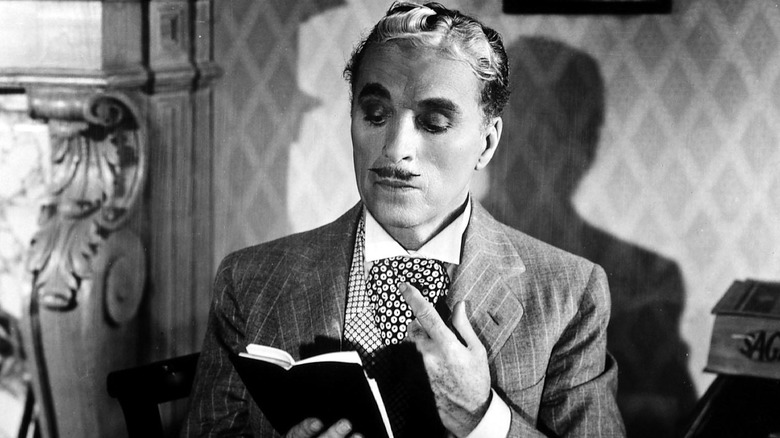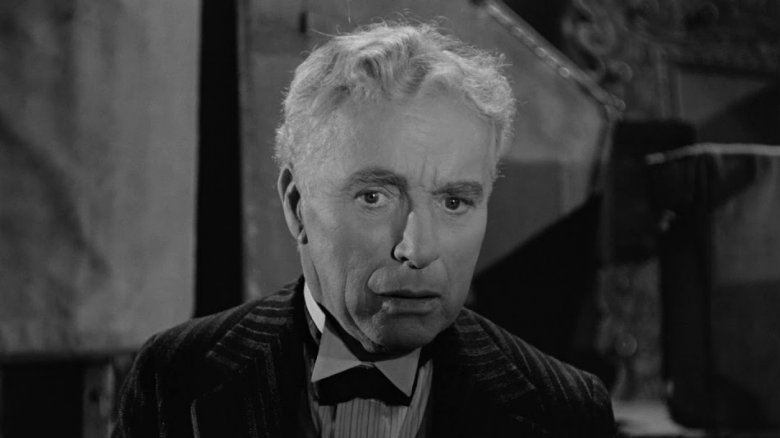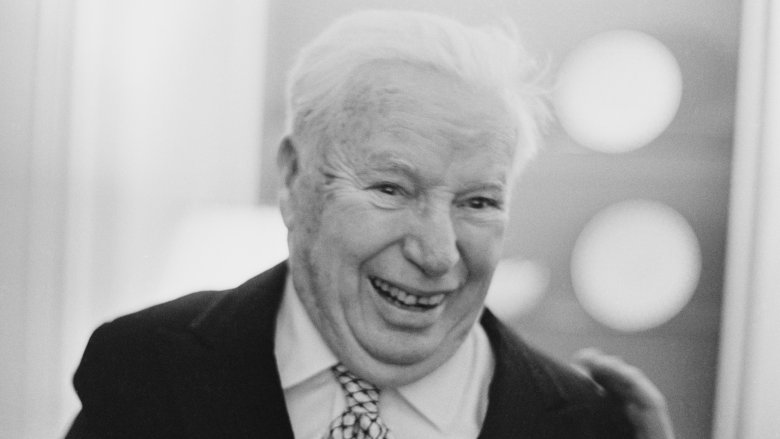Charlie Chaplin's Tragic Real-Life Story
No one in history has made people laugh as much as Charlie Chaplin. The Little Tramp was silent cinema's first mega star, a character so recognizable that The Guardian has called him "the most famous man who ever lived." Even today, there are people living in random, out-of-the-way places from Albania to Eritrea to inner Mongolia who would still be able to tell you Chaplin's name just from glancing at a picture of him. That was the power of Chaplin's timeless comedy: He could make you continue to associate things like toothbrush mustaches with laughter even after Adolf Hitler had ruined them for everyone.
Yet Chaplin's real life was as far from a laugh-a-minute as you can possibly get. While his films have been criticized in our cynical modern world for a tendency toward saccharin sweetness and blatant tear jerking, the guy dreaming up all this schmaltz was far from smiling on the inside. From his early years trapped in biting poverty in London to his later mauling by the American political establishment and his own inability to say no to his darkest temptations, Charlie Chaplin was a clown who wasn't just crying behind the face paint, but screaming his way through an absurdly bleak existence.
Charlie Chaplin's alcoholic father abandoned him
In 1890, Charles Chaplin Sr. was one of the hottest talents on the British stage. A comic singer, he was going up in the world even as he was settling down with his wife, Hannah Chaplin — a fellow vaudeville star — and their baby Charlie. Yep, Charlie Chaplin was actually the second celebrity to bear the name, after his own father. It might have been an honor, had Charles Chaplin the elder not been permanently soused.
The official Charlie Chaplin website tells the story. Drinking was a big problem among vaudeville stars in the 1890s, and Charles Chaplin was a boozehound like no other. By the time Charlie was 12, the old drunk was dead, killed by his addiction to the bottle. If this sounds tragic, now might be the time to mention that it was probably better that way. Charles was awful. When Charlie was just 1, his father walked out on the family, taking their means of support with him. Hannah and Charlie were plunged into grinding poverty, which Charles did nothing to alleviate. When he was at the height of his fame, presumably earning decent money, he was arrested for failing to provide for both Charlie and his other son, Sydney.
Despite their destitution, Hannah managed to keep a roof over young Charlie's head and entertained him with old vaudeville routines. It could have even been a poor but happy childhood. Sadly, almost nothing in Charlie's life qualified as happy.
A mother's madness
"Be careful what you wish for" goes the adage, and it's probably never been as apt as it was for young Charlie Chaplin. Always fascinated by his mother's vaudeville career, Charlie was mimicking her routines by the age of 5. It's not hard to imagine the boy wishing he could join her onstage. If that's the case, his wish came true in the worst way possible.
It happened during one of Hannah Chaplin's performances, while Charlie watched from the wings. According to Biography, Hannah was halfway through a song when she suddenly lost her voice. The manager panicked and shoved Charlie out. In what feels like the opening for a feel-good movie, young Charlie knocked everyone's socks off. In a kinder world, this moment would be the beginning of Charlie's career. Instead, it was the beginning of his mother's descent into madness.
It quickly became clear that Hannah's voice issue was just the first outward sign of the demons consuming her. As she and the children continued on in poverty, she drifted further from reality. Eventually, she was institutionalized. This being Victorian London, the "social safety net" was something tramps caught fish with. Charlie and his brother got chucked into the workhouse, which was exactly as Dickensian as it sounds. Charles Chaplin Sr. did briefly agree to take the boys in, but it didn't last (via the Charlie Chaplin website). Charlie would wind up spending so much of his childhood in the workhouse that he only ever received six months' schooling, as per The Guardian.
Endless, awful jobs
For the first 12 years of Charlie Chaplin's life, Charles Chaplin Sr. seems to have had fleeting pangs of conscience when he tried to help his kid, even if those pangs quickly vanished beneath a sea of booze. One such moment came in 1897, when the official Chaplin website claims he got his son into a clog dancing troupe to make ends meet. (Even this is uncertain. Other sources claim Hannah Chaplin's sympathetic showbiz contacts arranged the gig.)
Sadly, this wasn't Charlie's big break. But since when did fate make anything easy for young Charlie? The Eight Lancashire Lads went nowhere, and Charlie was forced to scramble for work to survive. According to Biography, this meant taking on an endless parade of awful jobs.
Charlie would later claim he'd been a newspaper vendor, a toymaker, a printer, a doctor's boy, and about a zillion other things. It wasn't until the 20th century that he was able to move back into vaudeville, and it wasn't until 1908 that it became a viable career. Signed to play the drunk in a comic sketch for Fred Karno's pantomime troupe, Chaplin even toured America. Evidently, America liked what it saw. In 1912, producer Mack Sennett signed the young comic to appear in motion pictures. This time, the big break was real.
The tyrant appears
Stanley Kubrick's name is a byword for artistic perfectionism to the point of insanity. Before Kubrick became the poster boy for tyrannical directors, though, there was Charlie Chaplin. After Mack Sennett signed Chaplin, the young comic's star exploded. According to the British Film Institute, Chaplin made 35 films in 1914 alone. By the second film, he'd created the Tramp character, as per the Charlie Chaplin website. By the 11th, he was directing. By 1915, he'd signed to Essanay Studios and been given his own production unit. By 1916, he was with Mutual Films, where he had complete creative freedom and the largest salary in Hollywood.
So, yeah, things were kinda going great for Chaplin, and they would continue to for the next few years. But this was also the period where Chaplin the crazy-on-set autocrat emerged. It would be the world's first real glimpse of the tortured, driven man behind the genius.
PBS has the details. Chaplin on set was a Chaplin obsessed. Known as the most demanding man in Hollywood, Chaplin would reshoot each scene hundreds of times. Rather than directing, he'd act out everyone's role for them, then say "do that." (Many years later, on 1967's "A Countess From Hong Kong," Tippi Hedren claimed this drove Marlon Brando crazy.) Chaplin would fire actors halfway through and start the film afresh, with all the bazillions of takes this implied. It was an insane system, but it worked. It also set the stage for the even darker Chaplin who would soon emerge.
Controversial marriages and unhappy allegations
By 1918, Charlie Chaplin was producing his own films, and making films that are still considered classics today, like "The Kid." Unfortunately, this is also when Chaplin's darkest side emerged. He began serially seducing young girls.
According to Vice, Mildred Harris was barely 16 when Chaplin met her, and at best an emerging starlet when Chaplin was the biggest star of all. He seduced her, thought he'd gotten her pregnant, and arranged a hasty marriage. When he found out the pregnancy wasn't real, he got her pregnant for real and then divorced her.
Maybe it was his father's inspiration, but Chaplin's next love would be even darker. He first met Lita Grey (above) when she was a 12-year-old child star in 1920, and spent the next few years doting on her, keeping her in his orbit until she was finally of age — maybe. In 2015 the Times of London claimed Grey was 15 when Chaplin seduced her, instead of the widely reported 16. Either way, he got her pregnant, married her, impregnated her again, and abandoned her in 1927.
There were other scandals in Chaplin's love life, too. The 1924 shooting death of producer Thomas Ince on William Randolph Hearst's yacht was rumored to be the result of Hearst trying to kill Chaplin for seducing his wife but accidentally shooting the wrong man. In a taste of things to come, Biography claims these seductions and salacious rumors would later see Chaplin banned from several states.
'Deeply dumb in many ways'
Despite the darkness of his private life, this period of Charlie Chaplin's career was conversely when his artistic light shone its brightest. In 1919, Chaplin set up United Artists with D.W. Griffith and Mary Pickford (via The Guardian), where he went on to make films that still define silent cinema, like "The Gold Rush." But it was when the Great Depression hit that Chaplin reached his peak. For weary audiences, the Tramp was the tonic they needed. "City Lights" and "Modern Times" really did fulfill that old cliche of bringing joy to millions, even as other silent stars like Harold Lloyd and Buster Keaton faded away.
By the outbreak of World War II, Chaplin wasn't just famous. He was an icon. A man who considered himself untouchable, which may explain what happened next. As the war got underway, Chaplin began making public speeches extolling the Soviet Union. According to Slate, in 1942 he praised Joseph Stalin's purges and said "the only people who object to Communism ... are Nazi agents."
Years later, Orson Welles, who worked with Chaplin on "Monsieur Verdoux," would call him "deeply dumb in many ways." He could have been talking about Chaplin's Communist speeches. With the establishment already against him over his private life and perceived "anti-Americanness" — including J. Edgar Hoover and gossip columnist Hedda Hopper — Chaplin had handed his enemies the stick to beat him with, then turned around and dropped his pants, too. The results would be anything but amusing.
Failed paternity and 'white slavery'
Ushered into law in 1910 by Rep. James R. Mann, the Mann Act's official name is the White Slave Traffic Act, and its original intention was to combat forced prostitution (via NPR). However, as History details, the act was worded so broadly that it could be used to prosecute almost any consensual sex act, provided one participant traveled to meet the other.
In 1944, Charlie Chaplin's personal life again exploded in a mess of seedy allegations, this time for supposedly impregnating and dumping actress Joan Barry. Previously, this would have stayed in the tabloids. But, emboldened by rising anti-Communist feeling in America, this time the establishment pounced. Chaplin was arrested for "immoral purposes" under the Mann Act, having allegedly taken Barry across state lines before seducing her. He was eventually acquitted, but the establishment was gunning for his blood.
Chaplin was sued by Barry for paternity payments. Despite medical tests that proved he wasn't the father, reported the Evening Independent, Barry won her case, and Chaplin was forced to pay out for a kid that was scientifically proven to belong to someone else. What remained of his reputation in America was shredded. But it was activity in Washington, D.C., that would really doom the Tramp. Specifically, the ironically un-American activities of the House Un-American Activities Committee (HUAC), and its witchfinder general Joe McCarthy.
The colossal flop
Let's pause here and take stock. It's 1947. Charlie Chaplin's reputation has been ruined by scandal and an unfortunate pro-Communist streak. Europe is shattered by war, America is devouring itself in a Red Scare, and all audiences want is for the Little Tramp to make them laugh again. Instead, Chaplin chooses to make "Monsieur Verdoux," an Orson Welles-scripted black comedy in which Chaplin plays a serial killer (pictured above) preying on rich old ladies. You can probably already guess the public reaction.
"Monsieur Verdoux" bombed hard. It nearly ruined United Artists. As Slate describes, the press junket for the film turned into a kangaroo court in which Chaplin was metaphorically lynched. The tabloids had announced in advance that they would make him squirm for his Communist leanings and, boy, did they ever. Chaplin almost had to abandon one press conference when all reporters did was accuse him of not being sufficiently supportive of capitalism. It didn't help that "Monsieur Verdoux" could clearly be read as a black satire on capitalism's worst excesses.
At the exact same time "Monsieur Verdoux" was ruining his career, Chaplin was put on notice by HUAC that he could soon be indicted. While he never was, the Little Tramp still became a favorite punching bag of senators like William Langer, who divided his time between demanding Chaplin be deported and trying to get Nazi war criminals off the hook. In the backward world of McCarthy America, it was Langer who emerged victorious.
Blacklist and exile
Although never formally indicted by HUAC, Charlie Chaplin was still blacklisted. Blacklisting ruined guys like Dalton Trumbo, but Chaplin was somewhat immune. He was rich enough to finance his own films, he owned a distribution company, and he was still popular enough that a group of followers would always watch whatever he made. Which may be why the aftermath of "Monsieur Verdoux" saw him back directing his last masterpiece, "Limelight." While America had clearly had enough of Chaplin, Chaplin's fame allowed him to go on working ... right until he got kicked out of the USA.
According to BBC, athough he'd been living in America for 40 years, by 1952 Chaplin hadn't applied for U.S. citizenship. He was still clutching his U.K. passport, which didn't endear him one bit to guys like William Langer. In the fall of that year, Chaplin decided to combine an international press junket for "Limelight" with a trip to Britain. He planned to be in Europe about four weeks. He wound up living there for 25 years.
On September 19, U.S. Immigration barred Chaplin from re-entry. Chaplin had given America claim to the greatest ever on-screen character, he'd elevated Hollywood movies into an art form, he'd helped millions forget their woes and, in return, he'd been vilified and ejected from his adopted home. He'd only ever return once. For the rest of his life, Chaplin was a man in exile.
His body was stolen after he died
The last decades of Charlie Chaplin's life consisted of crazy ups and downs. On the one hand, he only made two more films — "A King in New York" and "A Countess from Hong Kong." ("King" was banned in the U.S. for being "anti-American.") On the other, he settled in Switzerland with his wife, Oona O'Neill, and raised a remarkably happy family, according to his son (via The Telegraph). That's surprising because O'Neill was another of Chaplin's young conquests. Married when she was 18 and he 54, they nonetheless stayed together until Charlie died in 1977.
It would be nice to end Chaplin's story like that, with some semblance of peace after a hard life. But fate had one last, gruesome curveball to throw. Months after his funeral, two graverobbers dug up Chaplin's body and made off with it. They held the Tramp's remains for a couple of months, demanding a ransom payment of $600,000 (via Smithsonian).
But O'Neill was apparently made of steel because she refused to play ball, hanging up on the criminals rather than hear their demands. Panicked, the ghouls got sloppy, and Swiss police tracked them down. After a tortured life and a bizarre postscript, Chaplin was finally laid to rest, for good this time. He may have had a hard time, and he may have done some unpleasant things, but the Tramp is generally remembered for his laughter and his artistry, rather than his difficult life. He probably wouldn't have wanted it any other way.
